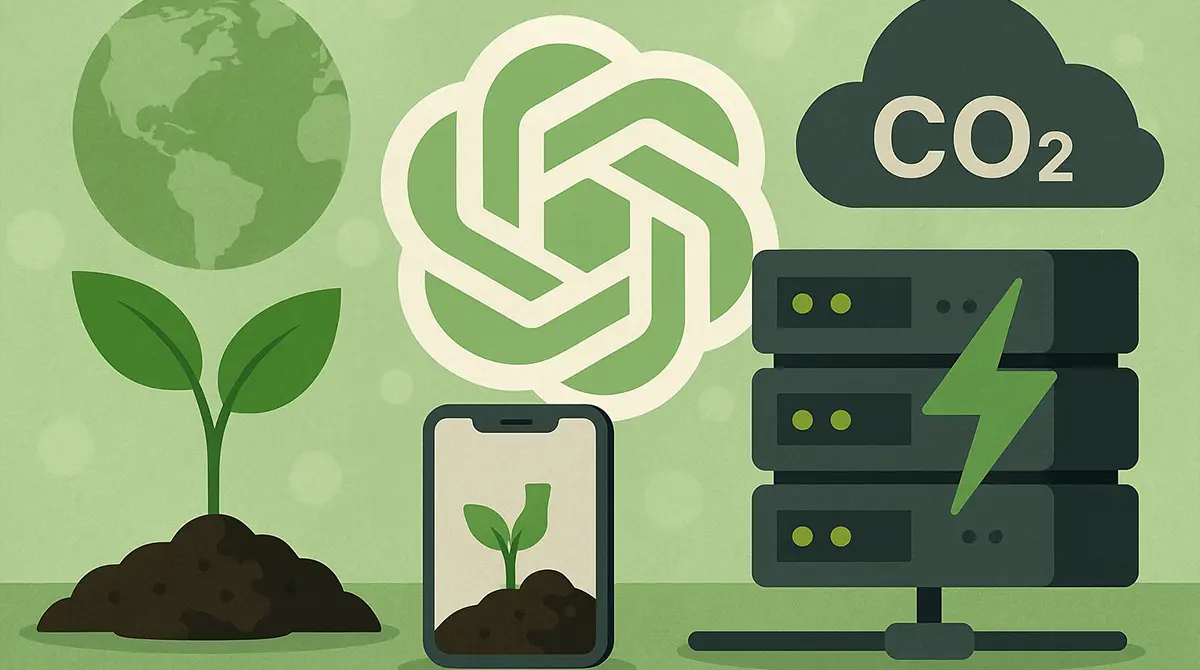From fetching today’s recipe to drafting research outlines, millions turn to ChatGPT every hour. But while the replies appear effortless, the physical nodes that power those responses hum 24/7 inside vast data centers. That quiet background operation sparks the question: how green is our beloved AI assistant? This article dissects the ChatGPT Environmental Effect, stripping away hype and greenwashing to reveal verifiable data, emerging fixes, and clear guidance for eco-conscious users.
How ChatGPT Uses Energy?
Understanding the journey from prompt to answer clarifies where watts are burned. The lifecycle breaks into six stages.
- Training the foundation model: Weeks of parallel GPU processing hammer graphics cards pulling hundreds of kilowatts.
- Model maintenance and fine-tuning: Regular tweaks, safety updates, and domain retraining keep the model fresh yet energy hungry.
- Inference phase: Each user prompt triggers forward passes across layers, demanding short but intense compute bursts.
- Network routing: Encrypted queries bounce through switches, load balancers, and CDNs before hitting the server, adding incremental overhead.
- Hardware cooling: Liquid loops, chillers, and air handlers prevent thermal throttling, often doubling server power draw.
- Standby overhead: Even idle hardware consumes electricity, so off-peak GPUs remain lukewarm unless workloads migrate.
Multiply this cycle by millions of prompts each minute and the scale of energy demand becomes obvious.
Carbon Footprint of ChatGPT
Concrete figures remain scarce because OpenAI has not released product-specific audits. We can triangulate from academic studies on comparable large language models and data center run books.
Training Emissions Estimate
| Component | Energy (MWh) | CO₂e (t) |
|---|---|---|
| GPU farm | 1,287 | 552 |
| Cooling | 515 | 221 |
| Data store / idle | 215 | 92 |
| Total | 2,017 | 865 |
Inference Emissions per Query
An ordinary conversational turn equates to roughly 0.001–0.002 kWh. North American grids emitting 0.35 kg CO₂e per kWh translate that to 0.35–0.70 grams per answer. If one active user averages twenty turns daily, annual footprint scales to about 2.6–5.2 kg CO₂e—comparable to boiling 60–120 kettles of water.
Those grams may sound trivial, yet 100 million weekly active users quickly aggregate hundreds of tonnes of CO₂e each week.
Factors That Make AI Less Sustainable
Several drivers erode efficiency and balloon the overall ChatGPT Environmental Effect.
- Rapid model growth: GPT-4 dwarfs GPT-3.5 in parameters, multiplying GPU memory hunger and training epochs.
- Redundant traffic: Circular humor prompts, casual tests, and auto-suggestions create non-essential compute demand.
- Geographic grid mix: Data centers in coal-reliant regions emit four times the carbon per kWh compared to Nordic hydro powered sites.
- Peak demand spikes: Viral events can cause sudden 10–30× spikes, forcing grid operators to spin up reserve natural-gas turbines.
- Hardware turnover: Rapid 12–18 month GPU refresh cycles generate electronic waste unless downstream refurbishment is prioritized.
- Water footprint: Evaporative cooling towers can consume over two million liters per megawatt of load, stressing local watersheds.
These constraints compound each other, turning what could be benign technology into a growing emissions hotspot.
What OpenAI & Tech Companies Are Doing?
Industry leaders recognize the optics and financial risks of unchecked emissions. Three levers dominate immediate action.
Renewable Energy Procurement
OpenAI’s supplier Microsoft aims to match 100 percent of AI workloads with carbon-free electricity purchase agreements by 2030. Contractual instruments drive wind and solar PPAs toward Iowa, Texas, and Illinois data center hubs where ChatGPT compute clusters reside. Early 2023 data show 50 percent annual matching on the primary PODs, up from 37 percent in 2022.
Hardware Efficiency Gains
NVIDIA’s latest H100 GPUs deliver 3× training flops per watt compared to the V100 generation used for earlier models. Int8 precision circuits reduce memory bandwidth pressure, slicing per-query joules. Meanwhile, Google’s TPU v5 and AMD’s MI300 alternatives push convergent efficiency envelopes, giving cloud vendors bargaining chips to drive power racks downward.
Cooling Innovations
Direct-to-chip cold plates and liquid immersion vats cut cooling overheads from 1.6× down to 0.4× of server load, trimming PUE toward 1.1. Pilot trials at South-Central US sites reuse hot loop fluid for adjacent office heating, creating district energy byproducts.
Can ChatGPT Be Used Sustainably?
Users and enterprises are not powerless. Deliberate design choices can reduce footprints by 30–60 percent while keeping value intact.
Green Deployment Tactics
- Query aggregation: Batch minor requests into a single prompt to minimize round-trip overhead.
- Session caching: Save generated boilerplate responses locally so repetitive prompts never traverse the network again.
- Model right-sizing: Choose smaller specialized variants for narrow tasks instead of defaulting to massive generalist versions.
- Regional routing: Route compute to providers advertising 100 percent renewable-aligned regions through carbon-aware SDKs.
- Industry pledges: Support vendors that publish model-level PUE, scope 2, and scope 3 emission disclosures instead of glossy overviews.
Several teams have already tested these levers and reported impressive results.
- EcoE-commerce GmbH: Combined prompt batching with model fallback to reduce inference kWh 42% while maintaining conversion uplift.
- Hudson City CRM Team: Caching routine email drafts trimmed monthly API cost 34% and indirect CO₂e 28% (internal audit 2023).
- Mid-Atlantic Copy Agency: Shifted usage to Pacific Northwest hydro-powered servers and cut AI-related carbon budget 55% overnight.
长尾 Impact of Smarter Workflows
Beyond single-query optimization, workflow-level shifts compound gains. Teams swapping inefficient internal wikis for AI-curated knowledge bases reduce both server sprawl and employee search latency. Marketing outfits leaning on generative bullet generation trim multiple revision rounds that previously rode email servers. Such indirect savings rarely make headlines yet accumulate fast.
Future Paths to Net-Zero AI
The ecosystem is racing toward integrated sustainability. Edge inference chips promise on-device execution, slicing network transit emissions. Regulators in the EU weigh mandatory energy disclosure labels for large AI models—similar to appliance efficiency stickers—pushing transparency. Meanwhile, academic consortia investigate lower-precision training recipes that retain model quality below 8-bit layouts.
Carbon-aware schedulers already exist in pilot codebases; they would move elastic inference loads across time zones to chase renewable overcapacity. Investors increasingly tie compute budgets to ESG metrics, amplifying market incentives. The interplay of policy pressure, engineering ingenuity, and financial alignment sets the stage for AI services that do not cost the planet.
Bottom Line
ChatGPT is neither carbon-neutral nor a reckless polluter on the scale of airlines or beef. It sits in a nuanced middle zone where user behavior, vendor choices, and grid mix determine the actual ChatGPT Environmental Effect. Individual steps—batching prompts, choosing green regions, favoring disclosed vendors—can halve personal footprints. Collective action around transparency, hardware innovation, and renewable procurement will drive the next order of magnitude improvement. The responsibility is shared, and the window to bend the curve is now.



